1st June 2022
The Spokesmen Cycling Podcast
EPISODE 299: In conversation with Marco te Brömmelstroet
SPONSOR: Tern Bicycles
HOST: Carlton Reid
GUEST: Fietsprofessor Marco te Brömmelstroet of University of Amsterdam’s Urban Cycling Institute
TOPICS: This show is a conversation with Fietsprofessor Marco te Brömmelstroet of University of Amsterdam’s Urban Cycling Institute
LINKS:
“Movement,” by Thalia Verkade and Marco te Brömmelstroet.
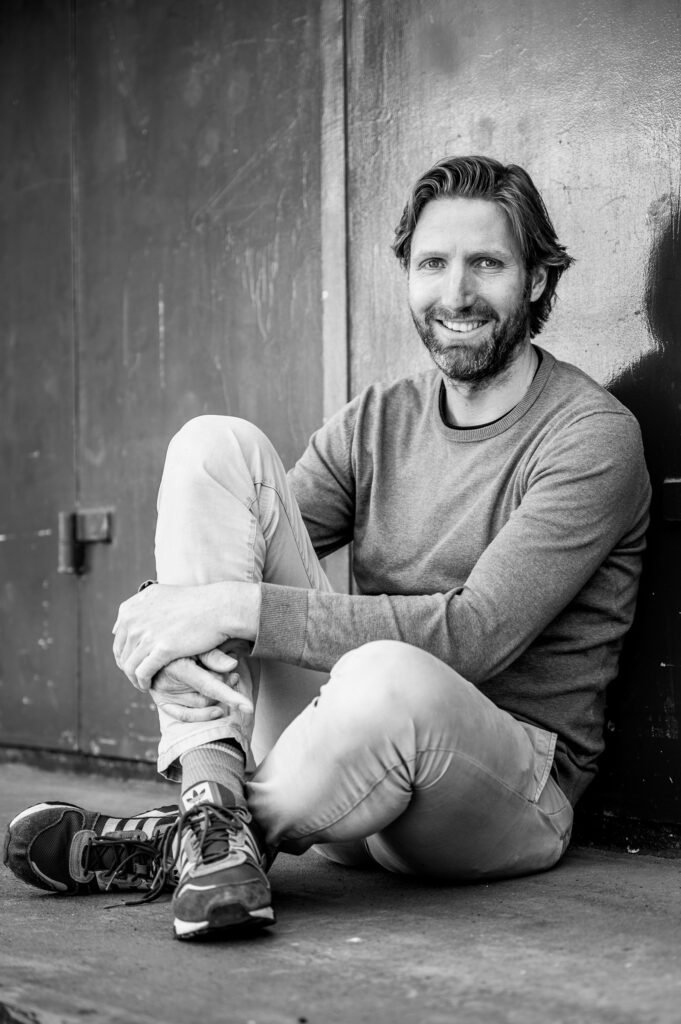
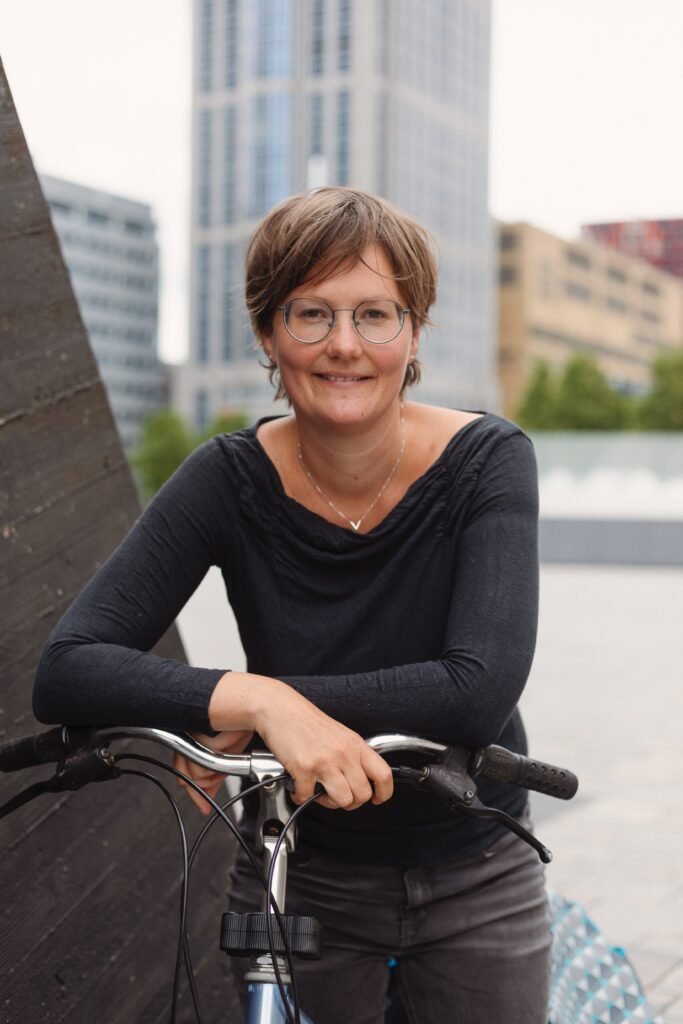
TRANSCRIPT:
Carlton Reid 0:10
Welcome to Episode 299 of the spokesmen cycling podcast. This show was released on Wednesday, first of June 2022.
David Bernstein 0:22
The spokesmen cycling roundtable podcast is brought to you by Tern bicycles. The good people at Tern are committed to building bikes that are useful enough to ride every day, and dependable enough to carry the people you love. In other words, they make the kind of bikes that they want to ride. Tern has e bikes for every type of rider. Whether you’re commuting, taking your kids to school, or even caring another adult, visit www.tern bicycles.com. That’s t e r n bicycles.com to learn more.
Carlton Reid 1:00
Thanks, David. I’m Carlton Reid, and welcome to the spokesmen. This episode is a conversation with “fietsprofesspr” Marco te Brömmelstroet of the University of Amsterdam’s Urban Cycling Institute. I started by asking Marco about an award given to the Dutch language version of the book.
Marco 1:22
Yeah, that’s that’s one of the things that makes me maybe makes me the most proud of the book. It’s seen by many as a transportation book, that we’ve written it as a general interest book, and it won a prize for best journalists book of The Netherlands in 2021. So there was a great sort of recognition that what we’ve written here is not only sort of a technical book about mobility, but actually touches upon important discussions that we want to have in the wider societal debate.
Carlton Reid 2:00
Yes. Now your co author here is and I’m hoping getting pronunciation right is Thalia Verkade.,
Marco 2:06
Thalia Verkade.
Carlton Reid 2:09
thank you. But she also she writes for The Correspondent, I mean, what is she? How well is she known in the Netherlands?
Marco 2:19
Well, she’s she’s known as a good journalist. That’s also how we crossed paths. So we, we met in, in a conversation that she came as a journalist for the correspondent, and she came to my my office at the time, academic researcher on cycling. And I had very high hopes, because I had already many conversations with journalists about cycling, but very often, they didn’t really take off beyond the point that cycling is nice, sustainable, cheap, or whatever. And I was really hoping because she was working for the correspondent, which is in the Netherlands, known as a platform for journalism Beyond The Beyond the daily fast journalism that really wants to go deeper. So I was really hoping that she would come by and we could finally have a conversation that I would find more important about what the street is what mobilities for and so on.
Carlton Reid 3:17
So what’s what’s the book called in Dutch in English, it’s movement. What’s it in Dutch,
Marco 3:22
Dutch, it’s had read from this Nelson, which would try and translate directly as the right of the fastest, or the winner, the winner takes all. Who comes first, first, first come first serve. But it’s sort of a pun on in touch, the actual statement is a threat for the statics to the right of the strongest or the right of the fittest. So it’s it’s abundant refers to the notion that in our public space on our streets, speed, has become the dominant indicator for designing the streets and for thinking about the streets. So we just take for granted that the right of the fast trumps all the all the all the other potential rights that we could also use to think about the street.
Carlton Reid 4:15
And as the book talks about is that also involves cyclists going travelling too fast as well?
Marco 4:21
Well, yeah, exactly. Yeah. So it is, in the sense that was already started that Toyota came to my office to talk about how I have cycling could solve all the mobility issues that we are facing a position we we see a lot of course in bicycle activism. And I started to ask her exactly those questions. So because for me, it really depends on what type of cycling what kind of cycling. What What’s that cycling symbolises? And I started asking her questions about if cycling would also represent the same notion of speed and going fast from A to B but now no longer on four wheels and in a cocoon, but on a slightly different version of them. Is that actually a better world or not? Are we then actually taking back the public spaces that our streets once were? Or are we just replacing the one of the problems with with a new one? So two that brought us to that notion that it’s not a question about bikes versus cars, it’s actually a question about the fundamental fundamental underlying notions such as speed is speed, dominating public space, if that is the case, then most other use of that public space can no longer no longer happen. And that applies both on cars but also on on bikes.
Carlton Reid 5:48
In the in the in the preamble to the book, Talia describes it, but it mentions the fact that you’re the cycling professor. And she said that was obviously a something that she was very, very interested in. And, and, and amused by, but then she says, In describing your name, and you can actually pronounce your name on tape here, because you said it. That second professor is a handy moniker for a man with a tricky surname. So even even Dutch people think your surname is tricky.
Marco 6:18
Like if it I think it’s tricky. Yeah, that was the one that was once the reason. So my name is Dutch Marco te Brömmelstroet., which is already a bit of a tongue breaker. And also has this strange, strange letters in it, that seems very confusing for people. So it was once the reason to call myself online on Twitter to use the handle fietsprofessor because the need it’s much easier to use and to, to remember. So that was also the the reason for her to come by.
Carlton Reid 6:57
So I’m glad it’s not just me that okay. Let’s, before we get into the book, and and and I’ve read it, and it’s fascinating as as as as I’d expect, I guess. Let’s talk about you, because I’ve come across you. And I’ve certainly put recordings on this this podcast of your summer school, and the University of Amsterdam. So just describe your work, including, you know, how you’ve, you’ve exported yourself through that summer school and getting international students coming to Amsterdam.
Marco 7:38
Yeah, so it started out with being an academic, I was working on very abstract concepts of use of knowledge by letters, I guess. And at a certain point in my career, I really wanted to focus more on on a topic that that was less abstract and more, more more tangible to work on. And I can at that time, I came to the conclusion that in the Netherlands, we have this crazy phenomena, known internationally the cycling culture, but in academic circles, nobody is known. I would say, by that time I was I was, my position was that nobody’s doing academic research on that. And I found out quite quickly that that’s not the case. But many people are doing research on cycling, but they don’t. They don’t make that an explicit point of the research. So there are many transport economists, transport historians, for instance, they do research that includes cycling, but they don’t call themselves the cycling historian or whatever. So at that point, I started to think about what could be the role of somebody who would take that symbolic notion of cycling, more central, in this case, the cycling professor. And one of the products that that immediately came out of that was this summer school, the notion that we could sort of put a ribbon around all this great and fascinating research that’s going on in the Netherlands, for foreigners recognisable as something that is about the cycling culture that they want to understand. But for all the researchers themselves, not something they would they put themselves on the podium for.
Carlton Reid 9:26
And it’s the summer school. How long has it been going for? Because I came to the first one, didn’t I?
Marco 9:31
Yes, yeah. So it’s, we are now going to run the six instal. But there were two years COVID years of course, no travelling salsa, no summer schools, because the summer school is why it’s very international 30 students every year waiting list of about 60 and we select based on on diversity of discipline, discipline, disciplinary background, but also geographical backgrounds. So brings together the world for three weeks in Amsterdam, and the whole notion and that became central in the the further work that I started to do around cycling, the whole notion is to get to get more confused on a higher level. So you come in expecting to, at least some students expect to learn the tricks of how to get cycling exported to their own context. But on day one, we already start to question why they why they should be interested in cycling, what questions can you ask about cycling? Why is cycling? So such a strong and relevant symbol? But also, what kind of mistakes could you make in sort of uncritically copying this notion of how cycling was implemented in the Netherlands? Because then you could you could also, if you take a more critical perspective, you could really question if, if you could start all new by introducing a cycling culture is then the way that the Dutch did it? Is that really the best possible example to do it? So it starts to question that in three weeks, the students get confused and a higher level, they go back to their own context. And that’s also where we now see, five, six years after the first cohorts is that they really become quite powerful advocates, but also political leaders and players that are asking those questions to actually make better policies.
Carlton Reid 11:30
Because the people who went to those first ones, you know, they’re often doing master’s degrees and PhDs and stuff, they’ve probably never finished those academic studies they have moved into into the world of power, I guess you could put it you are seeing the fruits of that, then you’re seeing that the first people who who joined and now actually, certainly starting to have their hands and the levers of power.
Marco 11:59
Yeah, exactly. Yeah. So did they, of course, have developed an international network that was really powerful, especially in the beginning, where they kept looking for each other, kept asking each other’s support when they were doing things, because the first thing that we noticed is that many of these quite activist players are researchers. Also, sometimes already policymakers, they felt quite lonely in their own context, fighting for something, not being aware that there was sort of a bigger international network. And now suddenly, knowing how big that network is, gives them a lot of, of power and leverage to go back. But also this this, the ability to ask different questions to link up to different players as well to to learn that cycling isn’t isn’t only a different form of traffic engineering, but it’s but it also is connected to issues of health or loneliness, or opportunities for children. So starting to talk to completely different different players.
Carlton Reid 13:06
You’ve touched on people there, and that’s actually on my next question, because an awful lot of cycling and transport is put into the category of you know, that that’s, that’s a science that’s, you know, you design roads, you designed streets, etc, etc. And that’s quite an abstract or very, very, not nice at all. But what what you’re doing what you’re doing, because you’re a social scientist, so you’re focusing not on the buildings or streets, you’re focusing on the people.
Marco 13:35
Yeah, and then and then to fold. And that’s also what I hope to bring back in the book. So on one hand, it’s indeed those spaces that we create, then serve people. So the question is, who do they serve? And who do they not serve? The Justice elements of that? How do people behave in those spaces? How do they interact with each other? It’s sort of the relatively straightforward, I would say, social, scientific questions that you can ask about how streets function as public spaces. But the second, the second element of where humans come in is how, how humans actually design create an engineered space, that’s also a human element, an element of what kind of knowledge do you use? What kind of language do you use to understand that those streets basically the streets that we know now have been created by decades of, of groups of people working on it, and that that is what makes the Netherlands for instance as a, as a context, very different from the UK. So I also want to understand how those processes work how humans come to decide to make certain things happen in certain contexts.
Carlton Reid 14:47
So you focus on people, but then on on, on on video, and in the book. There’s this concept which you like and cyclists, Two starlings, two beds, and that’s the flow. So can you tell our listeners here? What is the flow?
Marco 15:11
Pool? Well, that’s a tough one, it that’s one of those things that you actually I think, have to experience to understand that. So all the listeners should should come to the Netherlands and really experience that, of course, but it so the notion starts and I think that’s important to realise that both for me, starlings flow are examples of different types of concepts, narratives, language that you can use. So they are, for me really examples that help us to ask different questions. So if you look at the traffic, or at a busy intersection, and you use a different metaphor, different lens, in this case, the flocking behaviour of starlings, you start to see different things happening there. And you start to see different problems and also different solutions. So with the starling metaphor, you start to see that cyclists, for instance, especially when their speed is relatively low. They are very good in organising themselves and in self organising space in such a way that they don’t collide. That they are flowing themselves through that space, but also allowing others to, to use that as well, which is a notion which is almost contrary to how we engineer and organise those spaces we organise in traffic engineering, the holy grail of intersection is that it’s conflict free, that the technology and the design creates an intersection where people do not have to interact with each other. Because interaction is almost by definition, a conflict. Because people are egoistic. And they want to basically, they want to, they want to behave like a goose and not like Starling, they want to go fast, long distance, I don’t want to get interference of others. So this whole different notion of allowing the starlings to show their swarming behaviour in Amsterdam, in the end led to a complete overhaul of the way that we started to design intersections. So instead of putting cyclists into the, into the the norms that we had the design guidelines, we started to teach traffic engineers to observe how cyclists actually behave on an intersection or use their behaviour as a starting point. So that’s the starlings. The flow element is also an example of a flow, we’re trying to sort of to reappropriate that term from the traffic engineers, because flow in general is the amount of traffic that you can push through a street, but flow in, in positive psychology. It’s a concept developed by [….]. And it’s all about how we how our brains are wired to look for moments of flow. But flow in that sense are really that the moments that we have feel, as human beings feel optimal, that we that the amount of challenges that we face, meets our needs for the skills that we have. And those moments, I think we all know them, playing music, or having having this great afternoon at work, where time flies, basically, those moments, that’s what we crave for. And again, if you use that concept, you start seeing why. In the case of Amsterdam, again, cyclists are not always are very seldomly following the logic of traffic engineering of the shortest route from A to B. But they are optimising their route based on the amount of challenges that they want to face. So sometimes you go through the park, because you want to have easy going round. But sometimes you actually want the hustle and bustle of the busy streets, you see that cycling again allows the cyclists to really go for the optimal personal conditions, where they really look to to be challenged,
Carlton Reid 19:11
and don’t want to get into too many technical aspects. There isn’t that many in the book, it’s very much a people book, but then there is one that’s mentioned. So the flow is is is carried out at least two or three pages. But then there’s also this other one called chip cone. So can you describe what Chip cone is and whether that’s, that can be explored internationally?
Marco 19:35
It’s an it’s a fascinating example of how you translate the book. Because in Dutch it was it was a new term that is introduced exactly because of the traffic engineers started to observe the behaviour of cyclists and they found out that in the guidelines for how to design a good intersection, you basically draw straight lines from one side to the net to to the other, where cyclists can cross. And when it gets very busy in the case of Amsterdam, we started to see that that the amount of space that that creates for cyclists to wait for the for for the green light was was not sufficient, and they started to behave erratically. So then one thing you can do is to, to start behavioural campaigns and tell cyclists that they should still stay within that space, they should learn how to how to cue, they cannot use the Contraflow lane, because it’s dangerous. But instead, the traffic engineer started to, to do together with us and a group of sociology students to do observational studies. And through video analysis, they found that cyclists actually showed behaviour that allowed them to use the intersection much with a much higher capacity than you would ever have following the design guidelines. And the Chipko is the is the example that comes out of that the Chipko basically uses the logic of the Swarm, which allows on the site where cyclists are waiting, you give them more space in width, then the opposite direction. And then while crossing you, you slowly limit the width to the other side. So the line in the middle of the of the bidirectional bicycle path is no longer straight. But it’s, it’s, it’s with an angle, which allows the cyclist to go from six metre wide bicycle path in the duration of crossing the road to a two metre wide counterflow path. And that suddenly gives the whole vibe, the whole feeling of that intersection, it fits much better with the actual behaviour of the cyclists. And by doing that it’s sort of the traffic engineers of Amsterdam, one innovation price with that simple innovation. And it’s now applied across across the Netherlands and now even last week, so that they are now they are now transferring that knowledge to an intersection in Oslo.
Carlton Reid 22:13
Many, many road infrastructure for cars do this, it was all similar. There’s one in fact quite close to me in Newcastle, where it’s the time tunnel and maybe other roads under under the river tunnels do this as well, where they have credibly wide area for the cars to go through. Because we’ve got to get through all of the gates for the for the money, but then it then filters it into subject and pretty wide. And then it filters it down to this this narrow section. But what it kind of tend to do is people go very fast to kind of get into that. The bottleneck part. So what what what prevents or maybe actually facilitates? Do the faster cyclists, you know, go incredibly fast to get through and the slow ones just dogged along Is it is it is this the chip cone, it allows everybody to go at the speed they want to go at?
Marco 23:11
Well, I would say that it’s indeed an example that in touch is called Ritzer, or supercute. What is used it also well described by Tom Vanderbilt in his book traffic. It’s this notion that indeed you you, you funnel and in that process, you organise the funnelling and there’s all this science about what is the best thing to do, but what really makes a difference. And what I find so fascinating is that, in the case of if you do this in as car drivers in individual cars, you become competitors with each other will start to behave also competitively. You want to be in front of the others. I also noticed that myself if I’m in a car, well, this cyclists and also because they are much more able to organise in a very fluid way. It it gives much more the appearance of not not competition, but cooperation. So it’s much more a process where indeed almost automatically if you’re a fast cyclists, without having to tell that to anybody, you already positioning yourself in such a way that you will have an optimal flow yourself, but you are also not in the way of others. So you create the space for also altruistic behaviour where people that need protection are on the inside. And people that want to go faster, I want to take a bit more risk on the outside and that you don’t even have to teach people to do that. They do that automatically and lead function much better. That’s one of the big things that we found out in the in the in the chip code design, according to the standard conflict measurement tools that traffic engineers had the intersection functions less well because they were more conflicts according to that model. But what they actually found out when they asked the cyclist they I experienced much lower levels of stress because the whole design of the intersection fitted much better with how they already behaved.
Carlton Reid 25:07
Let’s talk toys. Because one of the things that jumped out to me from the book was and I have seen the campaign on social media to get Lego to redesign it streets. But then there’s just this this this little factory which was which was fascinating where cars are now taking up more space in Lego. So they are now a Lego car is now six studs wide, whereas it used to be four studs wide in the 1980s. That’s fascinating how how the real world has has been miniaturised in the toy world. Crazy.
Marco 25:45
And also the road plates we found out is that the standard road plates that basically we gave our children to develop their creativity with and they build cities still still with that, we found out that the amount of studs on the side so the sidewalks basically, disciples of the road plates went from eight to five studs. So they because to basically allocate the wider cars, you need wider roads. And there were actually discussions that still open. By the way, some people say that aren’t in the 80s on the road plates, there were a bicycle lanes, it’s open for interpretation, I guess. But it’s clearly no longer there. So the current road plates are really row plates where six stud wide cars, take all the space in the space goes away from from other things. And indeed, that’s what is so fascinating is that it has a two way relationship with reality. So first of all, it is indeed a better representation of what also happened in the real world in from the 1980s. To now that more and more space of our streets had to be allocated for bigger and bigger vehicles. But also it works the other way around is that if this is the creativity, if this is the the visual language that we give our children, when they start to think about their future cities on early age, it is really strange that we we are not thinking about alternatives for that, but we don’t give them any options to really think differently than then this way of streets. So they literally Lego in Dutch also says that with Lego you can make everything right, it’s really about reshaping the world. But it isn’t because we basically give our children not the option to develop it to design the city where streets are completely have a completely different role like a playground or so, we started to develop that together with partial statement and he went to the 3d official route. And in the meantime, also, because the book came out in the Netherlands, after that we have started to to 3d print our own plates, we now developed our own Dutch bone F Lego road plates, but also a roundabout and a bicycle streets and typical bicycle and separated bicycle paths road plates, again, to show that not that is not one ideal different version of the road. But that there are many possibilities if you think about the road as a as a public space.
Carlton Reid 28:25
And as Lego following up on that the real Lego
Marco 28:29
hardly hardly. So they they were sort of forced their hand by in the design, they have this desire Lego design ideas. And so we sort of Marshall Stein, man who’s in the book, he presented that idea to them, and then you had to collect 10,000 support statements, which was easily done because people really recognise why this should be lightweight. This was a fight worth fighting. But in the end, they decided not to take it into production. So we decided to make our own 3d version. And also the whole design is open source so people can now basically print their own road plates. But what really was fascinating also to find out is that there are many other toy makers. One example in the Netherlands, it’s called way to play. And they were also coming to the conclusion through reading the book that their own road plates that they were getting to Chile. We’re also very much monopolised that by the notion that roads were black asphalt, places for cars and they started to develop a cardboard version of their of their road plates and those cardboard versions had two amazing things. One was that they they now offer a downtown play version where children can already play with adding parks, doing all kinds of other stuff with the street the left side of the carport streets are empty. And this is really where the creativity of the children comes to the fore, they can really design their own streets that can fit their their own creativity. And I think that said, that’s the whole point here is that, that will start the creativity that we need. If we really want to have a transformational change to how our streets are designed in the coming decades.
Carlton Reid 30:24
The Jesuit idiom isn’t the you know, give me a child, you know, up to the age of seven, and I will give you the man. So it’s very important to get to get kids. I mean, we there’s not a child this thing this is this is actually very important to get kids thinking very early on that yes, roads are not just strips of black asphalt, they can be movement, isn’t the only thing a road is for? Yes,
Marco 30:49
no. And that requires that requires movements of people to also people themselves to become aware of that. So that’s that’s the also the notion in the in the book, Talia came to me to talk about bicycles, and I basically started to ask her questions about all the things she took for granted already. And that’s also what we heard back from a lot of readers in the Netherlands that the books would have opened their eyes to the things they took for granted that many people just see the street as something that’s just theirs, it has been designed by experts, there’s thought about that. And that’s that they’re not really happy with it. But they also don’t see it as something that you could fight for. And we show them that there’s, there’s there’s a need to fight for it, because it’s public space. And we have a lot of important societal problems that require space to be taken away from the street as we know it. But it’s also possible to do it, but the possibility that the notion that you can actually challenge that idea that the road is a, it’s a black asphalt space between buildings, challenging the notion and showing all these examples, that streets can also be places where children can develop their own autonomy, or where neighbours can meet each other. Where trees can can grow, where all kinds of things are, are possible. I think showing that to people creates the potential for transformational change for people that are then stepping up and creating their own personal or local movement.
Carlton Reid 32:25
And you also in the book, it describes the campaign you had where you did make some changes to your your child’s school. So there was a plan. But you tell me what was that what was the original plan for your child’s school and what did the eventual plan create,
Marco 32:43
that start with the notion that the school was presented in the middle of a neighbourhood, a new school, in an old factory building and then to the neighbours. The match was shown that there will be a school here, this is how the school yard will be designed. And many experts have thought about this. So this is really sort of the best that we can come up with. And that was presented in such a way to the neighbours. But when you looked at the map, it showed that our children would get less than three square metres of playground per child, which was just according to the norm, but only just and the reason why this was so limited was an I immediately spotted that but most people didn’t. But was that there was a huge case, right facility. So there was a school yard was 600 square metres and the case arrived was 1100 square metres, the kids arrived, we then allow parents to drop off their kids school drop off zone for for car drivers. And again, this whole thing showed to all the stakeholders involved. It was presented as you have to take this for granted. This is what the experts thought about this is how they put the puzzle together. This is what you get. So even the director of the school said, Well, this plan meets all the norms, but it doesn’t allow us any dreams. But we have to take it for granted. This is what we get. And we basically went there as a group of neighbours and said no, we don’t have to take that for granted. We can we can challenge it because the experts came with this notion because they followed the norms and the models. But those models are not they are not they are not law, they are not given. They aren’t they are also created with a certain purpose, we can challenge them, and we should develop alternatives. So we developed an alternative where we basically told the school asked the parents to not come by car, and even to a certain extent forced them to not come by car. And if you succeed in doing that, we are going to ask the municipality to from day one, reclaim this drop of zone as an addition to the school yard. And that addition to the school yard we now we now are basically one because we shown we’ve shown to the traffic engineers that the world didn’t collapse if you don’t allow car drive I wish to come close to school. And we also show to the to the children and to the to their parents and to the neighbours. What quality you can get back. It’s not only about not having cars around school, but suddenly you have 1100 extra square metres for children to grow for, for greenery. For the autonomous development of children, they have a much more space much more diversity of playgrounds now. And that quality was not it wasn’t on the table. It was not that somebody was against it was just not at the table. The radical monopoly, the whole notion that we have to design the school environment first and foremost, for for safe car traffic. That notion and the fact that you can challenge that was so new to all the people involved.
Carlton Reid 35:48
So it’s a movement the book has before and after photographs of that of your child’s school, so people can actually look at that and see the after one is much, much better. No, Marco, I’m going to we’re going to stop here. We’re going to have a brief commercial interlude. But I want to come back and talk about the liability law.
David Bernstein 36:12
Hey, all you spokesmen listeners, I hope you’ll excuse the interruption. But this is David from the Fred cast and the spokesman. And I want to take a few minutes out of the show to talk to you about our sponsor Tern bicycles at www.tern bicycles.com. That’s t e r n, like the bird bicycles.com Tern are committed to building bikes that are useful enough to ride every day, and dependable enough to carry the people you love. Now, last time, I told you about Tern’s Quick haul ebike but today I want to talk to you about a sibling to the Quick haul. And that is the Short haul compact cargo bike. The Short haul is a practically priced wait till the end for the price. You’re gonna love it cargo bike that’s been designed to get a rider plus an extra passenger and cargo from home to work, to school, and everywhere in between. And I think that when you see a Short haul, you’ll realise that it may be unlike any cargo or city bike you’ve ever seen. That’s because most cargo bikes are big and unwieldy. And most city bikes while they’re easy enough to handle well, they’re just they’re just not able to carry much cargo. And that I think is why Tern designed the short haul. The Short haul is shorter than a regular city bike making it nimble and yeah fun to ride. But it was also designed with an extra long wheelbase and low centre of gravity then that gives you a stable ride even when you’re carrying heavy loads. In other words, the Short haul offers the best of both worlds packing a sturdy build and a hefty cargo capacity into a compact package that just simply rides better. With a mass Max gross vehicle weight of 140 kilos or just under 310 pounds. The short haul can easily carry an extra passenger and plenty of cargo. It’s got extra long extra strong rear rack and that is rated to carry a hefty 50 kilos or about 110 pounds. And it can be configured to carry a child and a child seat, an older kid, a small adult, maybe even a dog. In addition to its rear cargo capacity, it can also carry up to 20 kilos or about 44 pounds with an optional front mounted rack. Oh. And the Short haul accepts a wide range of Tern accessories, frankly to many dimension here, so that you can carry everything from a yoga mat to fishing poles to an ice chest or as I said before, even the family dog, and because of its size, you can easily manoeuvre in crowded or small places, including buses and trains plus like the quick haul, the short haul includes Tern’s vertical parking feature, so you can roll the bike into an elevator and park it in a corner of your apartment. Now, like I said before, safety is a core value at Tern. So that’s why the Short haul was designed and independently tested to ensure rider safety and that’s also why they use respected independent testing labs and why every turn bike undergoes rigorous testing to ensure that every bike meets or exceeds comprehensive safety standards. Oh and did I mention the price before we’ll get this at a suggested retail of $1,099 or 1249 euros. The Short haul is turned most affordable cargo bike yet. Bikes are scheduled to start arriving in stores in q3 of 2022. So start getting your orders in now. And for more information about the short haul or any of terms wide range of bikes, just head on over to tern bicycles.com That’s t e r n bicycles.com We thank turned for their sponsorship of the spokesmen podcast. And we thank you for your support of Tern. Also, thanks for allowing this brief interruption, everyone. And now back to Carlton and the spokesmen.
Carlton Reid 40:16
Thanks, David. And thanks for the message from Tern. Now, I spoke before about the liability law because the movement, the book by Thalia Verkade and my guest today Marco te Brömmelstroet. Did I get that even partially correct?
Marco 40:37
That was recognisable. It was.
Carlton Reid 40:39
Thank you. So I’ll stick to mark it all fietsProfessor even that’s difficult for cycling professor.
Marco 40:44
Just just calling Marco.
Carlton Reid 40:47
Marco is much easier. Thank you. So Marco, the book has got lots of history in there. Which which I’m fascinated by. So So Thalia has gone back into archives and dug into stuff. And then there’s one bit which which I hadn’t realised the history went back quite so far on this. And that’s, you know, all the way back to 1924. The liability law. Now, whenever you mention this concept in the UK, you get a lot of kickback from bicycle advocates who say this, this law isn’t that important. It’s all to do with hard infrastructure we forget, forget all of these different laws, all we need are bypass. But the book is describing how this liability law has a very, very important psychological impact, nevermind, you know, a physical impact on reducing speeds, etc, etc. So just describe the Dutch liability law and how it is actually quite potentially more important than people might imagine.
Marco 41:55
First of all, it’s indeed important in Dutch there that these terms overlap much more I think, than than English. But it’s really indeed not about blame. The law is really about and also not about responsibility, but about liability. So it’s really about who, who’s basically paying in the end of the day, if there is a collision between two partners. And what I think he did a lot does it, it shows that everything you do in organising in designing the street, but also in organising the way that people interact in public space, everything you do is by definition, a choice in first principles. So you cannot come up with a way of organising that in, let’s say, an objective way. You always have to make, you always have to solve dilemmas. And what the history also of this slide shows is that if you make that explicit, it at least becomes something that you can you could then start talking about. So who is liable? Who is bringing in the danger on the street? And why is that so important? I do think that it’s it’s it has been watered down a lot that discussion, and I think it should be brought back more to the front, it became sort of an organising principle that’s in the backgrounds. And for men, it’s often also the Dutch discussions, mostly by by car drivers, or the organisations that that support them, is brought in the notion that Dutch cyclists also are now just throwing themselves in front of cars, because they don’t have any liability anyway. So it became a bit of a strange discussion here as well. So the current discussion still, I think deserves in all countries, but also in the Netherlands, to have the discussion again, about what are the first principles that are are behind that. And that leads also to the notion we also discuss in the book about why are we talking about, for instance, traffic safety, all across the world, also in the Netherlands, as as a matter of statistics that are talking about the victims? So why are we calling something a bicycle crash? Is it somebody on a bicycle is hit by a car driver? And all these elements also, they come back again, to that notion? What are the first principles that underlie this? What Why are we talking about safety? Why are we not talking about the danger itself, the liability law. And that’s also showing me that there’s discussion it wasn’t clear cut that there was a lot of discussion, and it was really one person fighting for that. But it was in the end. Also, for the person it was about this first principle to put the onus on those that bring in Danger on the street and not those that make a mistake.
Carlton Reid 45:03
In the book, there is a very painful episode that I haven’t heard discussed by you before. And I believe in a book that actually says that you may not have wanted to discuss it openly before, because then people might assume that this is why you advocate and you you study what you do. But do you want to describe what happened to you? Or what happened to a friend of yours, I should say, really, as a nine year old?
Marco 45:34
Yeah, when I was nine, I was, I was very close witness to my best friend being killed in front of my eyes, through a collision with a with a car driver. And yet we found out actually during its during the process of writing the book, Talia and I were talking a lot, of course with each other. And we sort of had this feeling that was more and more, I wanted to talk about the justice element and the fact that our streets have been designed as places that are now dangerous for, for, for basically, for everybody, but especially for children, and how unfair and unjust that was, so we more and more moved in that direction. So we started to talk about mobility innovations, electrical cars, bicycle highways, and more and more, we went deeper and deeper into the underlying questions, the questions of what kind of principles do we use to design that streets, but also what is even underneath that, so we were going deeper and deeper into into the rabbit hole, until we came to the point where I actually wanted to go from the start to discuss not how we could solve traffic congestion. But how we could make our streets more just, we started to discuss and develop ideas around how people were actually experiencing traffic crashes, how people that were losing their loved ones, were proceeding that how newspaper and media were playing a role in that. And more and more, it became clear to tell you that I had this personal experience. But it was also not easy to talk about that. And that’s, that’s because that became actually also a part of the book where we discuss that sort of process of opening up and I learned during the process to talk with other people that were involved. And actually, actually, through that process, we learned how important it is for society, but also for individuals, in this case, me to talk about those tragic events, and, and see them right in the face instead of ignoring them for years as a way to cope with the pain or to not have to discuss it, and also not have to discuss the consequences of it. For me personally, it was it was much better to, to basically it was painful, but I came to the conclusion that it was much better for me personally to to have that conversation openly with all the players involved, also the car driver herself. And that could that made us also draw the conclusion that that might also be important for society that we tend to not really talk about the the drama that happens every day, multiple times on the roads in the UK, and but also in the Netherlands, that we don’t really talk about that we sort of put it in, in terms that we don’t really have to face the fact that we actually are hurting and killing each other on a daily basis. And we think that we do need to have that conversation because that would lead to to a much healthier societal debate.
Carlton Reid 48:49
So when I was roughly that, that age, probably a bit younger, in fact, I think was probably seven, one of my best friends was also killed by motorist when I was living in New Castle, my auntie was killed in a motorway Smash. So, you know, virtually everybody on the planet knows somebody or has has witnessed like you You witnessed a road fatality. And yet, as you say it’s it’s just not really discussed. So when when I when I see a family torn apart by a fatality I kind of clear mind exercise and just think, well, that family would they rather that motoring, which has caused most of these fatalities, would they rather motoring just never existed and that their their family member would still be with them. If cars had not been invented it Do you think that’s a fair exercise to play? I always suggest we actually design these things out by, you know, autonomous vehicles or whatever. So what should we be looking at here never having the utility of a motor car dependent society, or just moving to a Vision Zero, where we have no crashes in the future?
Marco 50:19
Well, first of all, I’m so sorry to hear that, that it also affected affected you. And indeed, that’s one of the things that we’ve also learned by putting this story explicitly in the book, how many people suddenly become aware of the fact how close how people close to them, had that experience and basically, we, if you count the numbers, it’s indeed everybody knows somebody at least close by that’s that that lost somebody or we’re not even. It’s even unfathomable, how many people get severely injured. But also those all those people around all the even the first aid workers, but also, and I think that’s, that’s one of the one of the key points here, if we want to discuss it openly a society also the people that that that caused it, right, or that, at least we’re behind the wheel of a car, when this has happened, this the systemic nature of the violence, the systemic nature of how we do so it’s not even blaming, it’s not about blame, it’s that the whole system is designed in such a way that if you make one small error, basically, I think, another great book recently out by Peter Norton Autorama, he described it very nicely. It’s not human error, it’s species error. So we know that people are actually humans are not able to, to operate those machines in a safe way that it’s just you we are just, we are just clearly incapable of that. So we shouldn’t design and allow people to use those machines in such a way that they can so easily harm and kill each other. So which vision not which future we should go, I think that’s not for me to discuss. But I think we need to discuss it, I think we need to have much more open discussions by our policymakers and politicians that go beyond the notion that traffic safety is something that we have to teach your children that works traffic safety, that is something that is currently is a systemic feature of the of our streets, and it shouldn’t be, or at least it there’s also an option that it isn’t. And we use different logic. So in the 1920s, when the car came to our streets, we talked about this in terms of justice, now we talk talk about it in terms of effectiveness or efficiency. So traffic crashes are mostly discussed in the media as a nuisance, because they will they lead to closed roads, or congestion for X amount of people. And we are not talking about the deep, traumatic experience that whole families go through every day, every day. It’s amazing. And that’s on both sides. I think the main point is also people die, everybody dies in the end in one way or another. So we should opt for Vision Zero in terms of zero people are allowed to die in a way. If you if you can, for instance, in the Netherlands cycle to a very old age, you have so many health benefits, but you also of course then run the risk of dying while you’re exercising on a bike. It is really about the notion that we are killing each other. The notion is not that people are dying, the division 00 should be about zero people should kill each other I think.
Carlton Reid 53:52
So. Peter Norton’s book which you mentioned, Pete has been a frequent guest on this show. So his latest book Autonoroma is all about the perils of Magical Thinking really over autonomous vehicles, driverless cars, and in your book, yours intaglios book you have a black and that you describe it as a Black Mirror style. Well, it’s not a utopia dystopia where driverless cars you know, feature and the downsides of driverless cars. Absolutely feature. So where do you stand on on driverless cars and how that isn’t going to be quite as rosy a future as people tend to be told by the mass media.
Marco 54:45
Well, where does that so what my take on all those things is that we are also with with any mobility, innovation and almost any mobility discussion we are we are blind to or take for granted the underlying narrative If that’s being told, and with driverless cars, the notion that’s really strong, but it’s actually strong, I would say in almost any mobility innovation. And that is basically also the notion that led to the streets as we know them today, we have been working as society for decades spent a lot of money to create mobility systems with that same narrative. But that’s the narrative that we, as individuals want to go as fast and easy and comfortable as possible from A to B. And that’s, of course, partly what we want. But it’s, it is never the full picture. Because if you ask that as two citizens and you confront them, with the, with the ups and downs of that way of designing streets, we would have a much more adult conversation, I would say about all the different values that we that we want to be included when we, when we design the streets, and we are perfectly willing, most of most of us at least, were perfectly willing to sacrifice, going a bit slower from A to B, if that also adds much more quality to the street and the driverless car is for me just a logical next step in that sort of an uncritical acceptance of the notion that going fast from A to B is the key thing for an individual to do. And only for that reason already, we should be more wary about that. Because those notions as you say correctly, they almost by definition, lead to dystopia. By following one indicator that guides uncritically guides us towards a certain future, that future will, will become dystopian, almost, by, by default.
Carlton Reid 56:45
So I know that is one of the dark messages to was fewer autonomous cars, more autonomous children.
Marco 56:53
Yeah, or we don’t need driverless cars. We need carless drivers. But But that’s, that’s also it’s a position. And I would, I would argue that my my key point also is academic year is it’s not about which of these positions is perceived better. What we want to show in the book is that they are positions and you are by definition, taking a position. And it’s not sort of the future is given or technological innovations will come and we have to deal with them. No, you take by definition as a politician, as a policymaker, as a parent, as a as a consumer, as a citizen, you are taking a position and we want to show to people that they should be more aware and more reflexive on that position by showing that there’s also a future where we could design our cities as places that are not where people are not dependent on vehicles and technology to bring them to valuable activities, that that is actually a possibility, then you open the realm of choices, you also show to people that they can actually fight for one on one or the other. So one of the notions that I’ve found amazing is the book in The Netherlands is used a lot by politicians. These days, we just had the municipal elections. And we see that in many of the current coalition agreements, the book plays a role, which is really cool to see. But it’s still remarkable how little how little divergence or difference there is in the mobility paragraphs of different political parties. It’s almost like they don’t see that there’s really fundamental principle choices to be made. So the discussions, the mobility discussions in the end are about what kind of technology you favour. Do you favour transit? As long as it’s electric or green? Do you favour electrical cars? Or are you a bicycle enthusiast? Well, the discussion I think, should be much more about what to what kind of future do these technologies lead? What kind of public spaces do we want? What kind of engagement with our fellow citizens do we aspire to as a society? And there’s, there’s there are very few contexts where I see that happening.
Carlton Reid 59:08
It’s good to hear that your book is it’s been used by politicians, that’s good, even if they may be missing the point sometimes. So let’s talk about your book in where people can get it, who is published by all that kind of information? So people have been fascinated by this conversation, and they’ll be fascinated by your book, where can they get it?
Marco 59:30
Well, the book is published by Scribe publishers in the UK for now and for those that are listening from outside of the UK, it can be ordered through to Blackwell publishers or Blackwell bookstores, and they ship it across across the world.
Carlton Reid 59:53
Okay, and well where can people here I mean, we’ve already talked talked about fietprofessor, so that we now we’ve got your social media hand No, but where can people find out about the summer school?
Marco 1:00:05
The summer school is it’s actually, it’s a programme by the University of Amsterdam. So you should go to Google in this case. And if you Google planning the cycling city, or University of Amsterdam, you can you can sign up for the diversion of next year, because this year is already full. Sadly, for those that will still want to come, but what we do also offer since since we found through the summer school, the enormous amount of, of craving that there is for disguise of knowledge, but also this kind of confusion, I would say, we also offer these programmes as open online courses, so you can find them on Coursera Coursera, you can follow the course unravelling the cycling city, it’s a four week course, for free. And we also put up a new a new one, which is called getting smart about cycling futures, that really takes you by the hands through thinking about especially cycling innovations, and thinking critically about what kind of cycling futures we are creating with different types of of innovations. So that’s, I think, the go to if you really want to go deeper into this rabbit hole.
Carlton Reid 1:01:16
Okay, thank you. And also another go to, which is mentioned, because the back of the book has got loads of action plans with the here’s what you can do, here’s what you can read, etc, etc. And one of the things it says is Go follow the people or go for the things that aren’t the lab of thought.co. So what’s the lab of thought Marco with the
Marco 1:01:35
lab of thought we are creating a foundation, where we bring together in first, the first instalment of the foundation, we bring together law, large mobility innovators and policymakers. So a number of international cities, but also a number of international mobility innovation companies. And with the lack of thought what we are going to develop together with them is increased what we call cognitive leniency. So we together with them, we teach them to become more reflexive about what narratives what language, what kinds of images, or imaginaries do they use when they think about the future that then in turn solidify into their innovation? So what kind of future are they basically creating? And what happens if you start questioning those what what happens with with the products of those companies if you start developing them from an alternative, imaginary, and what that directly leads to, hopefully, and that’s what we’re going to find out in the coming months, is all kinds of alternatives, prototyping. So one of the prototypes that we’re currently working on is redevelopment basically, of the standard traffic safety school programmes that are being used across the world. We found out that the imaginary the narrative that they use is traffic safety is a responsibility of our children, and they have to learn at a very early age to cross the road safely. And what we are developing as sort of a prototype counter narrative for that is that we teach that active citizenship we teach the children are from an early age that they can actually go to places and fight for safer streets so that their safety is guaranteed. That’s an example of a prototype of a very different mobility innovation, that that hopefully leads to a very different mobility future.
Carlton Reid 1:03:35
Thanks to Marco te Brömmelstroet there. This has been episode 299 of the spokesmen cycling podcast brought to you in association with Tern Bicycle. Thanks for listening and watch out for the next Sardinian-themed episode popping up in your feed real soo. Meanwhile, get out there and ride!
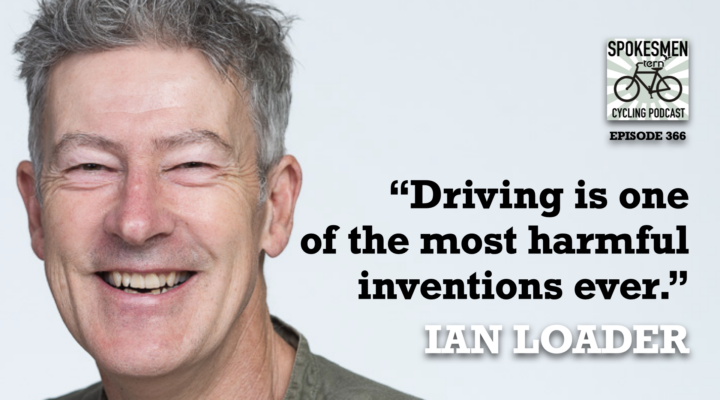
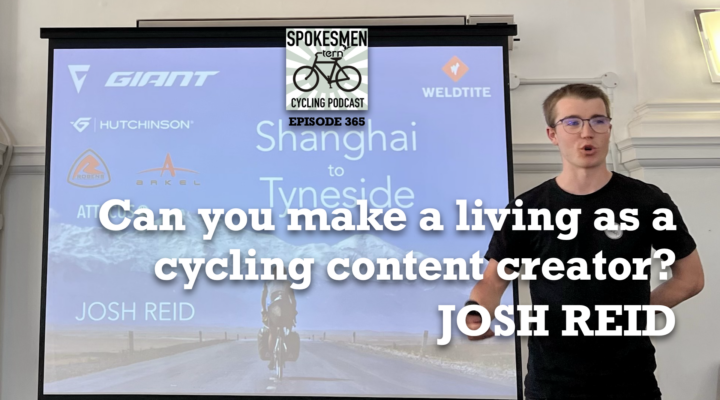
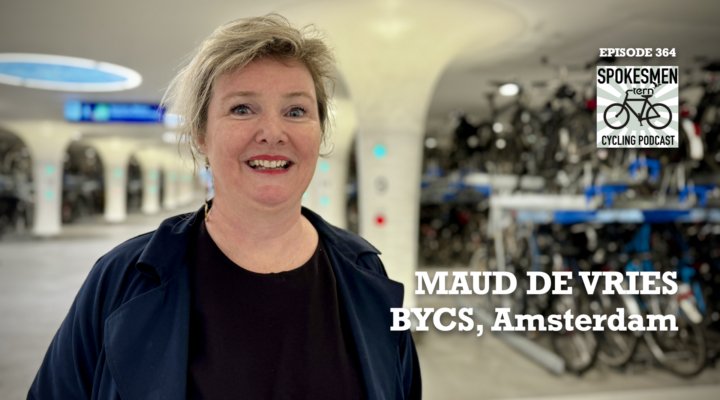
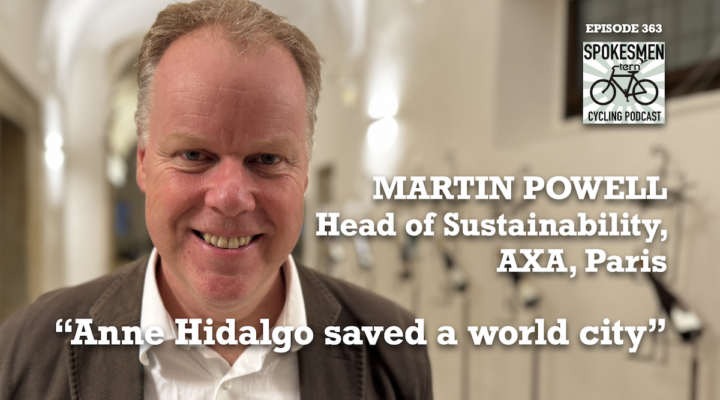
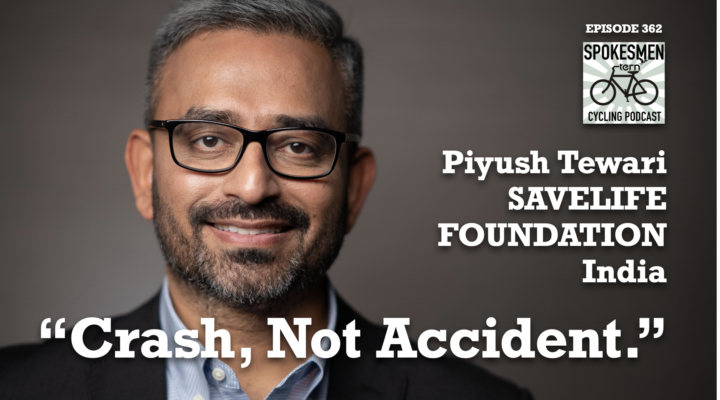
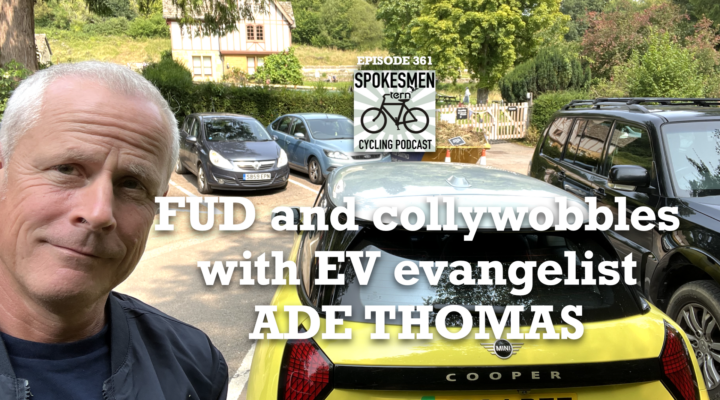
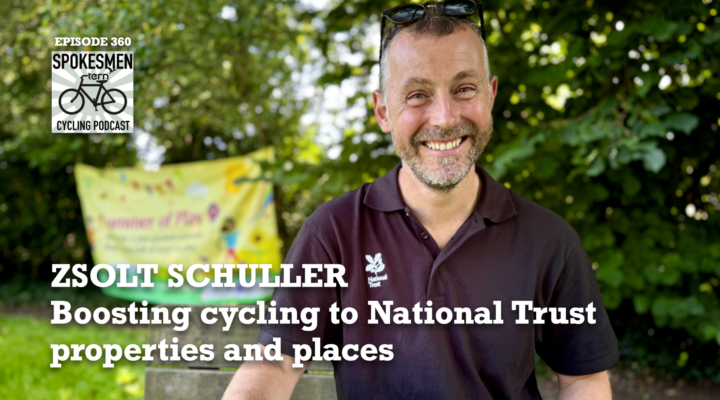
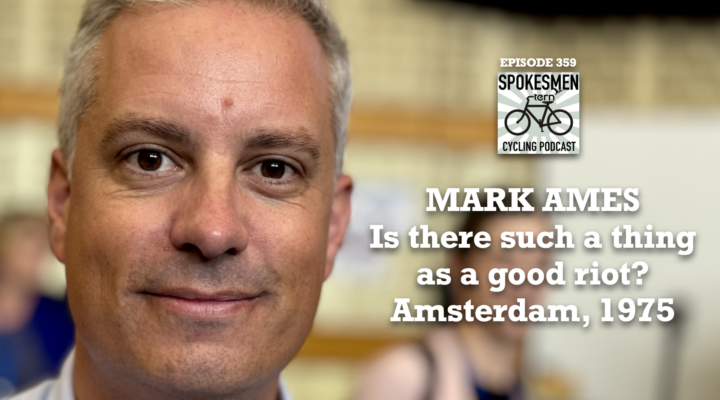
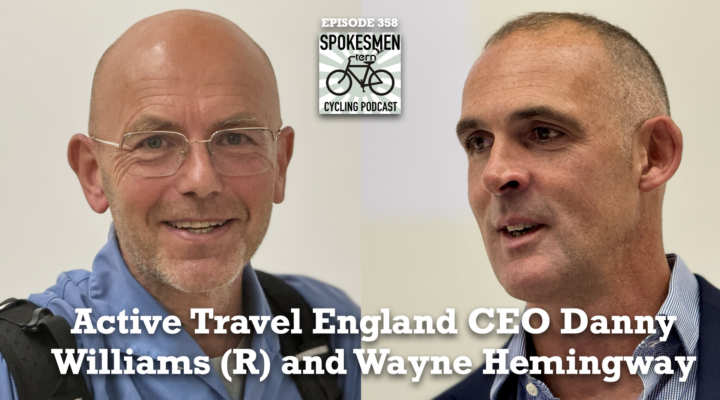
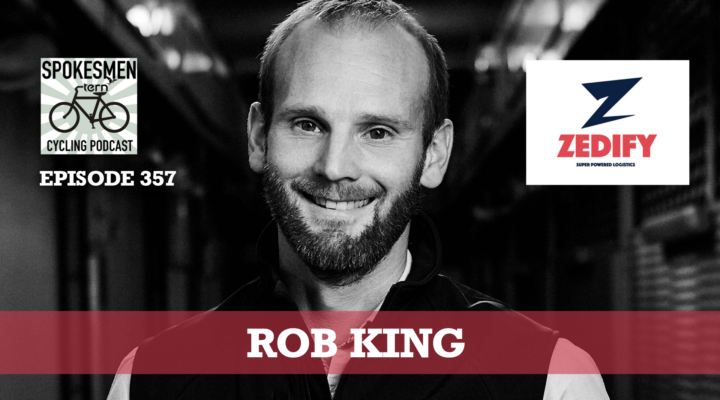
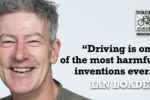
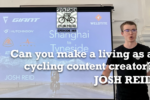
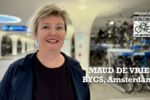
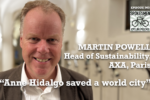
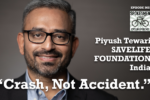
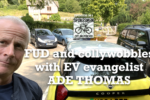
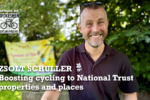
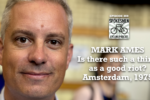
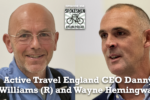
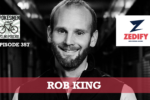
Be First to Comment